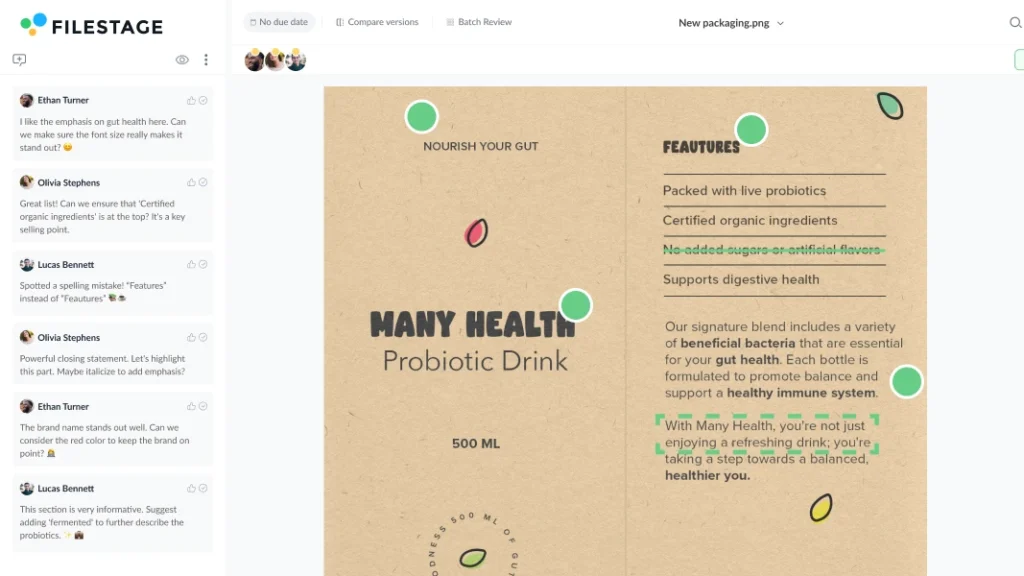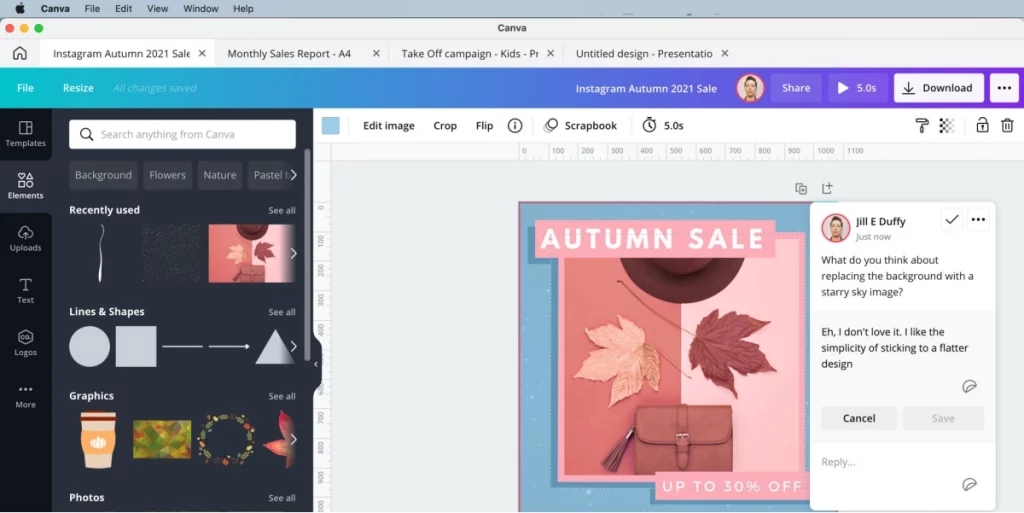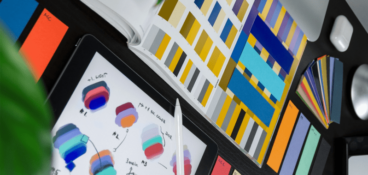Catalogs are the crème de la crème of marketing collateral. But if you want catalog marketing to work for your business, each element needs to be carefully thought-out and well-executed. Otherwise, you run the risk of appearing unprofessional and untrustworthy. Not a good look!
In this article, I’m going to show you how to make a product catalog that’ll help you wow your audience and win new customers. I’ll also share some of my top tool recommendations to help you out with different parts of the process.
But before that, let’s find out what makes catalogs such a powerful marketing tool.
Why do catalogs work?
The humble catalog has been around for yonks (since 1948, if we want to get specific). And it’s not hard to see how this marketing material has managed to stand the test of time.
Whether you want to showcase your product range, give audiences more detail on the services you offer, or promote your next big seasonal sale, a well-made product catalog can help you do it all!
Here are some of the key benefits that come with making a knockout catalog for your customers.
They’re convenient for customers
Unlike social media ads or email marketing campaigns, catalogs allow your customers to engage directly with your business. They can flip through pages, circle items of interest, and keep the catalog to hand for as long as they please. This makes for a more enjoyable and memorable browsing/buying experience.
They’re highly informative
Product catalogs provide ample space for quality images and detailed product descriptions. This visual presentation can effectively showcase different product features, benefits, and variations to help your customers make informed purchasing decisions. So, both print and digital catalogs can be a great way to build trust and customer loyalty.

They allow for more targeted reach
Catalogs can be strategically distributed to reach specific target audiences through direct mail, in-store displays, or even email inboxes for online catalogs. By distributing your catalogs in the right place and at the right time, your business can reach those customers who are more likely to be interested in your products. This makes for more effective marketing efforts and a higher conversion rate.
They have staying power
Catalogs have a longer shelf life than other printed or digital marketing materials. For example, your customers can revisit a print or online catalog multiple times, and even share it with family or friends. This helps support prolonged brand engagement and increased chances of conversion. It also gives you more bang for your marketing budget!
Less review rounds, better designs
Get quick and clear feedback right on top of your designs with Filestage.
How to make a catalog online
Great catalogs are much more than just a list of products or services. When done right, they have the power to help your brand streamline the customer journey and create more meaningful connections with your target audience.
Let’s dive into the key steps it takes to make a catalog your customers will love!
Step 1: Define your goals
For starters, your target audience, their needs, and interests should be the driving force behind every piece of marketing material – including your product catalog. Getting an in-depth understanding of your audience will help you pin down the purpose for your catalog.
Once you know who you’re talking to, you can start to think about the key things you want to say with your catalog:
- Do you want to tell customers about your new product range?
- Do you want to guide them through how your services usually work?
- Or do you want to introduce your brand to new customers?
By outlining the goal of your product catalog in this way, your team will be able to make sure every element, from layout to messaging, works together effectively.
Step 2: Collect and curate your content
Before diving into your print or digital catalog design, you’ll want to research, gather, and organize your content for each page, from the all-important front cover to the back cover. This will help guarantee that your catalog tells a cohesive story and ticks all the boxes it needs to without becoming too cluttered.
Some things you might want to think about when collecting content include:
- High-quality graphics and product images
- The different services your business offers
- Company information
- Customer testimonials
- You contact information
Step 3: Design your catalog layout
When you’ve gathered all the content you need in one place, you’re ready to start the layout creation process.
Most businesses work closely with a graphic designer during this stage to make sure everything looks professional and on-brand. Of course, you can always find free catalog design templates online, but I’d still recommend collaborating with a design professional along the way. The designer will be able to help visualize your ideas in a unique way and give guidance on how to build your catalog effectively for the best results.
Here are some of the main elements you’ll want to consider when designing your catalog layout:
- Your catalog’s shape and size
- Front cover and back cover
- Your introduction pages
- A table of contents
- Pricing information
- Calls to action
- Brand elements
- Individual page layouts – header, footer, thumb index, category colors, page columns
Step 4: Create an attention-grabbing front cover
The front page of your product catalog will determine whether people will take a peek or chuck it aside. Which is why you need to take the time to create something that stands out and leaves your audience wanting more.
Your front cover should aim to include:
- Bold and attractive visuals – Use vibrant images or designs that capture your brand, product, services, campaign, or concept.
- A compelling headline – Craft a catchy headline that speaks directly to your target audience and shows the benefit your offering has for them.
- A subheading with more information – It’s a good shout to add a subheading that gives the reader more context or highlights special promotions.
- Clear branding – Use brand colors to create a cohesive look that is instantly recognizable. And of course, make enough space for your brand logo.
- A call to action (CTA) – Add in a CTA that encourages immediate action and entices them to take a closer look at your catalog.
While there are lots of things to take into account when creating your catalog’s front cover, it’s important to take care that your cover design doesn’t become too cluttered or crowded. It should be clear and simple so as not to overwhelm or confuse potential customers.
Step 5: Craft your messaging
Now that you’ve got the layout of your catalog mocked up with an irresistible front cover, you’re all set to focus on what you want to say throughout your catalog.
Unlike most other advertising and marketing materials, catalogs give you the time and space to go into more detail and craft a compelling story. Every word needs to be carefully considered so that it adds to your customers’ experience.
Here’s a topline guide of how to craft some cracking copy for your catalog.
Pick and stick to a consistent tone of voice
If you don’t already have your own set of brand guidelines, you’ll need to take the time to define the tone of voice (TOV) you want to roll with. Your TOV should fit in with your brand’s identity and speak to your audience in their language. It also needs to be consistent from front to back to ensure a seamless reading experience.
Start with a strong introduction
It’s a good idea to set the scene with a brief intro or welcome message that lets readers know what they can expect to find inside. You might want to use this section to highlight any special promotions, new collections, or simply give an overview of who you are and what your brand is about.
Perfect your product descriptions
Next, let’s talk about product details! You’ll want to create some clear, concise, and compelling product descriptions that emphasize key features, benefits, and unique selling points. It’s important to include the necessary practical information here too, such as dimensions, materials, care instructions, and anything else needed to help your customers make informed decisions.
Tell a compelling story
Stories have the power to create emotion, connection, and a longer lasting impression on your audience. You might want to share the inspiration behind a collection, customer success stories, or the craftsmanship involved in creating your products. Or maybe you could use anecdotes or case studies to illustrate how your products can enhance the lives of your customers. Think about how you can tell a story that gives greater meaning to the product or service you’re selling.
Add value with educational content
Could your catalog provide some valuable information that educates your customers? If so, this is a brilliant way to position your brand as a knowledgeable and trusted resource! Educational content can take the form of how-to guides, usage tips, maintenance advice, or industry insights.
Step 6: Review your catalog content
No creation process is complete until your content has been reviewed by the right people and their feedback has been addressed. This will help you catch and correct mistakes, ensure consistency and accuracy, and improve the overall quality of the finished piece.
It’s important to have a solid review process in place to avoid losing precious time chasing feedback and digging around for different file versions. I’ll share the perfect catalog software to help you streamline the way you review catalogs (and every other kind of marketing project) in just a sec!
Step 7: Print and distribute your catalog
Once your catalog has been signed off, you’re ready to print! At this stage, you’ll want to think about print size, format, and material. If you don’t already have one, it’s a good idea to go with a reputable printing partner for the best results. Comparing quotes and print samples is the best way to find a suitable printer. Of course, if you’ve created an online product catalog, you can skip this step.
When distributing your catalog, you can choose from a range of channels to make sure you reach the right audience effectively.
Some examples of catalog distribution channels are:
- Direct mail – Send your print catalog directly to your customer mailing list
- In-store distribution – Place catalogs at checkout counters, customer service desks, and other high-traffic areas within your store
- Events and trade shows – Distribute catalogs at industry events, trade shows, and conferences to reach a broader audience.
- Partnerships – Collaborate with other businesses to include your catalog in their stores or mailings
Three best tools for creating catalogs
Now that we know the steps involved in creating a knockout catalog, let’s take a look at some catalog software that can help streamline your processes for a faster creative workflow.
1. Filestage for reviewing catalog content

Filestage is a review and approval platform designed to make it easier for teams to review and give feedback on a wide range of different file formats (PDFs, designs, documents, HTML files, and more). This makes it the perfect piece of software for sharing and developing your catalog designs.
The platform is super easy to use and it works by giving you one place to collaboratively review content, track changes, and approve files with a single click. That means no more lengthy email chains. No more missed feedback. And lots more time to focus on creating the best work.
2. Canva for designing catalogs
If you’re looking for an intuitive and easy-to-use tool to help you create stunning catalogs in no time, Canva could be the tool for you. Canva’s free plan is packed with useful features, including over 250,000 free templates, 100+ design formats, and a range of design tools.

People love Canva as it offers a simple solution for creating custom designs without the need for extensive training or design expertise.
3. Asana for managing catalog creation

With so many different elements to consider, creating an impactful, on-brand catalog requires lots of collaboration and communication between team members. Which is where a project management tool like Asana can come in handy.
Asana is a popular project management software that allows businesses of every shape and size to assign tasks, track progress, and manage deadlines effectively. You can use it to manage your catalog creation process from start to finish.
Final thoughts
Catalogs are a great way to connect with new and existing customers alike. But only if they’re planned and executed well.
Hopefully this article has inspired you to create eye-catching online product catalogs and print catalogs for your business. And if you’d like to see how Filestage can help you get the best work approved faster, start your free trial today.










